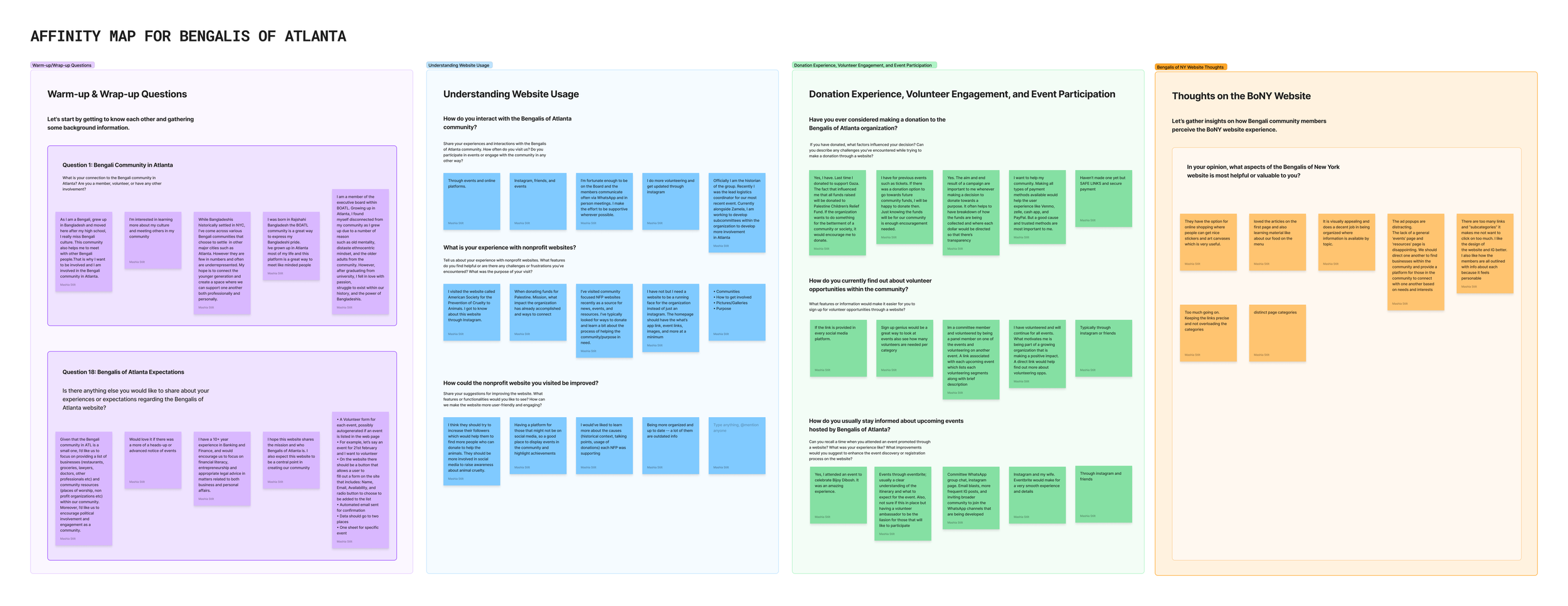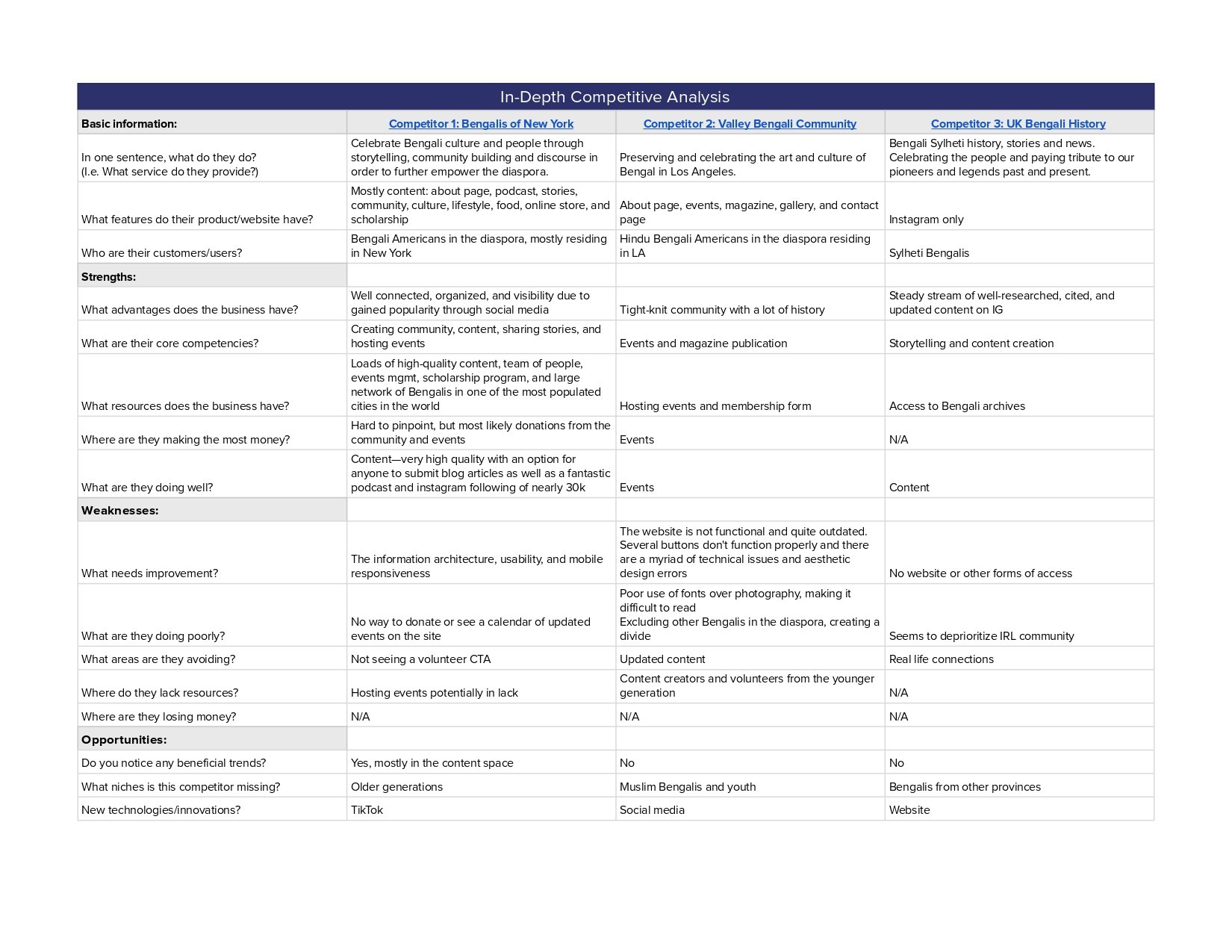Background
Bengalis of Atlanta was founded in the Fall of 2023 by Malika Begum with a simple yet powerful goal: to bridge the gap and foster connections among Bangladeshi youth and professionals in Atlanta. Recognizing a lack of community tailored to the younger generation, Malika saw an opportunity to create a space that addressed their unique needs and aspirations. Most existing community events were geared towards older adults, conducted in Bangla—a language many of our American-born youth are not fluent in—and failed to address the societal pressures of today.
Within just a couple of months of its inception, word spread fast across the Bengali community, and a need for a website emerged. The vision for this website is to house a digital record of the organization’s mission, leadership, communications, events, as well as creating a shared space to celebrate and promote connection—all while ensuring accessibility on both desktop and mobile devices. The goal of this project is to design a responsive website for Bengalis of Atlanta, a blossoming community nonprofit.
After meeting with the organization’s leaders, we understood the primary objectives to be communicating information, creating a volunteer intake form, and sharing event details through a user-friendly and intuitive web interface.
Research Insights
The goal of my research is to understand community members’ needs and wants to improve the online engagement and user experience of the Bengalis of Atlanta website. The research aims to provide actionable recommendations for the website’s functionality, user interface, and overall user satisfaction, ultimately fostering a more engaged and supportive Bengali community in Atlanta.
Objectives
Assess the current level of involvement of individuals in the Bengali community in Atlanta through various online platforms and events.
Evaluate the effectiveness of the nonprofit website in meeting the needs and interests of its users, particularly in terms of information accessibility and feature utility.
Identify barriers and challenges faced by users when making donations or signing up for volunteer opportunities through the website.
Gather insights on how users stay informed about events and their experiences with event promotion and registration on the website.
Analyze user feedback to pinpoint areas of confusion or difficulty in navigating the website and suggest improvements.
Collect demographic data to understand the diverse backgrounds of community members and how it relates to their online experiences.
Methods
Competitive research to gather information on how other websites in a similar space look and feel (i.e. Bengalis of New York)
Conducted interviews with 5 community members. During the interview, we got to dig deeper, ask follow-up questions, and gather qualitative data.


After conducting the interviews, I pulled direct quotes onto an affinity map. Once that was done, I could easily visualize patterns and recurring themes.
Patterns or themes gleaned from the interviews:
A deep interest in being a part of a community
Expectations for the website
Feelings [subcategorized]
Disjointed/loneliness
Desire for more
Excitement
A desire to support Bengali-owned businesses and the community at large
Access to event information
Curiosity to learn more about Bengali culture and history
User Personas
Using the research, the next step in my process was to create user personas based on the real people I interviewed and surveyed. To help establish a clear purpose, I was able to identify the unique personas above.
Problem Statement: Today, the Bengali community in Atlanta wants to engage more with their community, contribute more meaningfully, and attend more community-building events.
The Solution: We envision a space for the Bengali community, where they can engage in a digital space to get connected with other Bengalis from the Atlanta area on a single platform where the nonprofit organization and its members can provide updates and access to community resources.
The Why: They struggle to do this because there isn’t one centralized space they can go to find all this information. Additionally, the founder of BoATL has to juggle multiple communication channels and donation paths to provide this material, which is a challenge because it's not all housed in one place.
User Flows
Now that the research phase was complete, it was time to dive right into the good part. The alignment on feature set and task flow was instrumental in delivering a successful UX project for Bengalis of Atlanta. It facilitated clear communication, efficient execution, and stakeholder satisfaction, all while adhering to project constraints.
Feature Set
Home Page:
Description: A welcoming and informative landing page that encapsulates the organization’s ethos, highlights key initiatives, and provides easy navigation to other pages.
Prioritization Rationale: The home page is often the first point of contact for visitors. It should reflect the organization’s identity and guide users to explore further.
About Us Page:
Description: A detailed page explaining the organization’s mission, vision, leadership, and values.
Prioritization Rationale: Transparency and clarity are essential for building trust with users.
Events Page:
Description: A visual display of upcoming and past events, gatherings, and cultural celebrations.
Prioritization Rationale: Keeping users informed about community events enhances engagement and participation.
Volunteer Opportunities Page:
Description: A page listing volunteer roles, responsibilities, and upcoming events.
Prioritization Rationale: Facilitating community involvement is crucial. Users should easily find volunteer opportunities.
Business Directory:
Description: A comprehensive directory of local businesses owned by Bengali community members.
Prioritization Rationale: Supporting community businesses fosters a sense of belonging and economic empowerment.
Social Media Widget Feature:
Description: An interactive widget that connects users to Bengalis of Atlanta’s Instagram profile, encouraging them to follow the organization on social media.
Prioritization Rationale: Enhancing online presence and community engagement
Responsive Design and Accessibility:
Description: Ensuring the website works well on various devices and adheres to accessibility standards.
Prioritization Rationale: Essential for inclusivity and usability.
The Brief
As the project lead, I was responsible for creating the brief and delivering all deliverables outlined within it. This included overseeing every aspect of the project from concept to execution, ensuring alignment with stakeholders, and adhering to time and budget constraints—which involved:
Teaching Myself Webflow: Learning a new tool to publish the website design effectively.
Brand Identity Design: Refreshing the visual elements to reflect the organization’s values.
Photography Selection: Curating images that resonate with the community’s culture.
Copywriting: Crafting messages that communicate effectively with the target audience.
Website Execution: Building and testing the website to ensure functionality and user-friendliness.
Building a Responsive Website
In the process of delivering a live website for the Bengalis of Atlanta, I faced the challenge of scope creep and tight deadlines, which precluded the luxury of creating mockups in Figma or conducting usability testing. Despite these constraints, I was determined to ensure the website’s functionality and aesthetic appeal. Leveraging my skills in Webflow, I crafted each feature—a total of ten site pages. To address responsiveness across various devices, I utilized Webflow’s built-in tools to test and adjust the layout dynamically. Additionally, I sourced a high-quality template that aligned with the client’s budgetary limitations, opting for free options that did not compromise on design integrity. This approach allowed me to deliver a polished, responsive website that met the organization’s needs and maintained a professional standard within the given constraints.
Takeaways
This unique project not only sharpened my skills in responsive web design and client collaboration but also instilled in me the values of adaptability and resourcefulness. The joy of creating a digital space that serves the Bengali community, marrying aesthetics with purpose, was a personal highlight of this experience. Despite challenges such as budget constraints and unfamiliarity with the webflow platform, the project’s success was a testament to overcoming obstacles through learning and perseverance. The unexpected discovery of a Bengali-owned business directory (gathered from real user feedback) enriched the site’s value, showcasing the importance of thorough research. Trade-offs were made judiciously, prioritizing usability and budget without compromising on the nonprofit’s goals. The key takeaways from this experience—flexibility, empathy, and collaboration—are principles I will carry forward into future projects, ensuring that my designs are not only functional but also deeply impactful.







